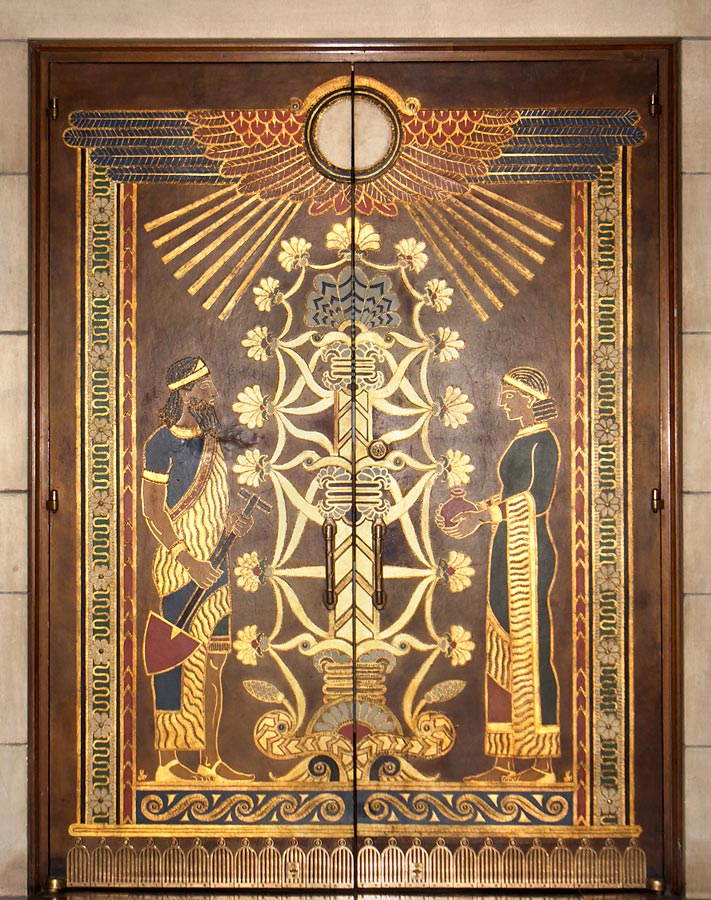Hildreth Meière Documentary Series - Watch Trailer
Hildreth Meière Documentary Series - Watch Trailer
Commissioned by: Mayers, Murray & PhillipIconographer: Hartley Burr AlexanderArtistic Collaborator: Hartley Burr AlexanderMedium: paint and gilt on leatherExecuted by: Baldwin Brothers for Irving Casson

House of Representatives, entrance door from rotunda
Hartley Burr Alexander wanted the entrance door to the House of Representatives to work visually with sculptor Lee Lawrie’s carved walnut door at the entrance to the Senate Chamber across the rotunda. In considering what medium to choose, Hildreth Meière wrote to Alexander:
It seems to me that it is to serve as the only door between the Rotunda and the Chamber, and must swing easily to the touch, which eliminates anything like a heavily carved door such as Lawrie’s opposite.1
Although she ruled out heavy wood, she liked the dark color of the walnut that Lawrie had used and that was also used for the beams below the ceiling in the House of Representatives:
...with a walnut colored door one might use gold decoration, relieved with some cream white, which would very much recall the ceiling of the house.2
Meière turned to Alexander for the iconography so that she could begin to think about a design:
The door certainly calls for enrichment, but you have gotten me so trained to try to express a thought in design that I find it almost impossible to begin anything until I know what it is all about.2
Alexander suggested figures of Adam and Eve in Eastern-style clothing to balance Lawrie’s design of a Native American male and female:
The center part would be essentially the Gothic-arched tree pattern, which can be very handsome. On each side, we should have a figure, an Adam and an Eve. I think, however, that I should not make of them nude figures, but with Oriental tasseled garments, such as the old designs show. They ought to be conventionalized, almost heraldic supports, and they need not face toward the tree, unless you prefer. You could give Eve...and the Adam...symbols of the Bread of Life and Water of Life.4
At the top of the doors, Alexander requested a winged disk to symbolize heaven:
For the top of the pattern, I think a winged disk, as symbol of heaven would be very good. You could give the disk, which would divide into hemispheres where the doors open, a more brilliant color or at least a solid color, which would make it carry as an abstraction, while the wings would be very ornamental. If you like, you could carry rays below the wings. There should be a border, but this need be no more than a conventionalized, geometric pattern, or flowers and fruits, if you do not find this too much.5

Detail of Gothic-arched tree pattern with Adam and Eve
Stylistically, Alexander suggested that Meière study Tree-of-Life designs on Ancient Asian seal cylinders. He told her to make her design of Creation just Assyrian enough:
Do not make it too Assyrian, but enough to give the Mesopotamian suggestion...The idea that I am suggesting may not appeal to you, and if you prefer to treat the subject in a more classical style, that is worth trying. It is the subject rather than the style that seems to me important. I believe, however, that you will like the Oriental pattern; for a door it is hard to beat, and on painted leather should be stunning. Wish it might be embossed!5
Hildreth Meière, letter Alexander, June 28, 1932. Hartley Burr Alexander Papers, Ella Strong Denison Library, Scripps College, Claremont, California.
Meière, letter to Alexander, June 28, 1932.
Meière, letter to Alexander, June 28, 1932.
Alexander, letter to Meière, July 8, 1932. HBA Papers.
Alexander, letter to Meière, July 8, 1932.
Alexander, letter to Meière, July 8, 1932.